3.0 FY06 PROGRESS IN THE PARTICLE ASTROPHYSICS
PROGRAM
by Roger Blandford
Appendix B Self-Evaluation FY2006
Return to Table of
Contents
The Kavli Institute for Particle Astrophysics and
Cosmology (KIPAC) has completed its third full academic
year. The KIPAC faculty has been joined by Professor
Risa Wechsler who works in the area of cosmic structure
formation and by Panofsky Fellow Saurabh Jha, whose work
focuses on supernovae and their use as cosmological
probes.
As of Oct 2006 there are 18 postdoctoral researchers in
KIPAC. The new recruits are Marcelo Alvarez, Andres
Escala, Stelios Kazantzidis, Masamune Oguri and Lukasz
Stawarz. KIPAC continues to hire the very best young
scientists, working across the wide range of topics
under the KIPAC mandate. (This year's hires were
selected from an outstanding field of approximately 120
applicants.) Over 30 graduate students are now
associated with the group and morale among students and
postdoc members is very high. At the administrative
level, Ziba Mahdavi has joined the group. The current
KIPAC membership can be found at
http://www-group.slac.stanford.edu/kipac/ .
The six postdoc members who came to the end of their
time at KIPAC in the past year have all moved on to
prestigious positions. Anatoly Spitkovsky has moved to
Princeton University as Assistant Professor in the
Department of Astrophysical Sciences. Andrei Frolov has
moved on to Simon Fraser University as Assistant
Professor in the Department of Physics. John Peterson
has moved on to Purdue University as Assistant Professor
of Physics. Masao Sako has moved to the University of
Pennsylvania as Assistant Professor of Physics and
Astronomy. Phil Marshall is the TABASGO Fellow at UC
Santa Barbara. Ted Baltz has taken up a staff scientist
position at SLAC. Three grad students have moved on to
postdoc positions at other universities. The success
rate in the job market for KIPAC student and
postdoctoral members is clearly very high.
KIPAC has become well-integrated into the SLAC-campus
physics community. Joint astrophysics seminars take
place on Thursday afternoons, the venue alternating
between campus and SLAC; these are well attended. There
is good coordination with other lecture series at SLAC
and on campus. There are twice-weekly KIPAC `morning
teas,' one on campus and one at SLAC, where recent
papers and `hot topics' are discussed and short research
presentations are made by group members and visitors.
Attendance at these meetings typically varies between 50
and 70. KIPAC has achieved the goal of providing a
lively and open scientific forum, connecting SLAC with
campus. Further outreach has also occurred into the Bay
Area astrophysics community.
Administratively, the KIPAC-Physics department has been
running smoothly. More than 80 individuals are now
associated with KIPAC Physics, with 27 individuals
receiving partial or full funding support through the
department (6 faculty, 7 staff, 8 postdocs and 6
students). The various subdepartments of KIPAC-Physics
have continued to operate efficiently within their FY06
budgets.
The new Fred Kavli Building has been a tremendous
success. The open design of the building has enhanced
the spirit of lively, open discussion and has fostered
further collaboration and the sense of `team' within the
Institute. The new Physics-Astrophysics Building on
campus will be completed in early October 2006 and bring
further opportunities.
The scientific program at KIPAC is diverse with
wide-ranging efforts on observational, theoretical,
computational and experimental fronts.
Given the nature of modern particle astrophysics and
cosmology, this maximizes the opportunity for
significant progress. In addition to the work directly
related to major projects, reported below, over 100
scientific papers, including conference proceedings,
have been written by KIPAC members over the past year
and a comparable number of talks has been delivered.
Major research concentrations include, in no particular
order:
-
cosmological studies of clusters of galaxies,
combining observations
made using X-ray, optical and radio telescopes.
-
projects in weak and strong gravitational lensing as
well as microlensing, investigations of particle
dark matter
-
studies of dark matter, dark energy and cosmological
parameters
-
participation in the Sloan Digital Sky Survey,
particularly in the discovery and analysis of
supernovae
-
participation in radio observations of the sources
likely to be studied by GLAST
-
modeling of pulsars, especially the recently
discovered double pulsar
-
modeling of gamma ray bursts
-
numerical simulations of the growth of structure in
the early universe
-
analysis of microwave background observations
-
calculations of atomic transitions for use in X-ray
astronomy
-
new ideas in black hole astrophysics
-
studies of astrophysical jets, accretion and galaxy
formation.
KIPAC looks forward to further growth over the coming
year.
GLAST
The Gamma-ray Large Area Space Telescope, GLAST, is a
satellite-based experiment under construction to measure
the cosmic gamma-ray flux in the energy range 20 MeV to
>300 GeV, with supporting measurements for gamma-ray
burst (GRB) transients in the energy range 10 keV to 30
MeV. With a sensitivity that is more than a factor of 30
greater than that of the EGRET detector on the previous
Compton GRO mission, GLAST will open a new and important
window on a wide variety of high-energy phenomena,
including super-massive black holes and active galactic
nuclei, GRBs, supernova remnants and cosmic ray
acceleration, and searches for new phenomena such as
super-symmetric dark matter annihilations, Lorentz
invariance violations and big-bang particle relics. The
GLAST launch is scheduled for late 2007.
The Large Area Telescope (LAT) is the primary science
instrument on GLAST. The LAT collaboration is a novel
teaming of particle physicists and high energy
astrophysicists. The collaboration now numbers 86
scientific members, 85 affiliated members and 23
postdocs and many graduate students (5 currently at
SLAC-Stanford). The LAT Principal Investigator (PI) and
Spokesperson is Professor Peter Michelson (Stanford and
SLAC). The LAT has been developed in a partnership
between NASA and the DOE, with substantial contributions
from Italy, Japan, France and Sweden. The LAT project is
managed at SLAC.
The LAT collaboration had a 3-day meeting in Stockholm
in August 2006, preceded by splinter meetings of many of
the 9 science groups organized in the collaboration, and
followed by a one-day science symposium on gamma-ray
bursts.
The integration of all 16 towers, the Anti-coincidence
Detector and data acquisition electronics onto the LAT
support grid was completed at SLAC in May 2006. The LAT
was then trucked to the Naval Research Laboratory in
Washington, DC for environmental testing, including
vibration, acoustic, electromagnetic interference and
thermal-vacuum testing. These tests verified that the
LAT successfully operated after being subjected to
launch-like stresses and the expected temperature
extremes of on-orbit operating conditions. After a
successful post-test review on 15 September 2006, the
LAT arrived at General Dynamics C4 Systems in Gilbert,
AZ on 18 September 2006 ready to be integrated onto the
GLAST spacecraft. The development of the LAT flight
software is nearing completion. The final launch-ready
version of the software will be installed on the LAT in
November, before initial testing of the integrated
GLAST. The integration and test of GLAST will last
approximately 9-10 months at General Dynamics before
GLAST is transported to Cape Canaveral for launch.
Preparations for the operation of the LAT continue at
SLAC. The LAT Instrument Science Operations Center
(ISOC) at SLAC will operate the LAT in conjunction with
the GLAST Mission Operations Center (MOC) and GLAST
Science Support Center (GSSC) at NASA Goddard Space
Flight Center, and will process LAT detected event data
and provide reduced data to NASA and the LAT
collaboration. Most of the ISOC staff have been
consolidated into the Central Lab Annex building at
SLAC. Construction has started on the LAT ISOC
Operations Facility in the Central Lab Annex, comprising
an operations control room, office area for operations
staff, and a dataflow lab housing a full-scale replica
of the LAT flight electronics and eventually the
flight-spare detectors. The construction of the
Operations Facility is scheduled for completion in
January 2007.
Data Challenge 2 (DC2) was held during March-June 2006,
following on from DC1 in 2004. DC2 used a simulation of
55 days of LAT data generated using 200,000 CPU hours on
400 CPUs in the SLAC computer farm. DC2 provided
end-to-end testing of instrument simulation, event
reconstruction and science analysis tools including
pulsar timing, GRB detection, and the analysis pipeline
for generating the LAT source catalog.
From July to September of 2006 a beam test was conducted
at CERN in the Swiss-French border, using spare modules
of the LAT assembled into a mechanical support grid. The
test article, hereafter calibration unit (CU), consists
of 2 complete LAT towers (tracker, calorimeter and tower
electronics module), a third calorimeter and tower
electronics module, a trigger module, and 5 plastic
scintillator tiles from the anti-coincidence detector.
Data were collected in the CERN PS beam line during the
months of July and August using low-energy beams (up to
10 GeV) of photons (tagged and untagged), electrons,
positrons and hadrons. Data were collected with the CU
in the SPS beam line in early September using beams of
photons, electrons and hadrons at several energies up to
280 GeV. Further data taking with the LAT CU will be
conducted with heavy ion beams at GSI/Germany in
November.
Work to understand the LAT acceptance, proton rejection,
and response functions using ground Cosmic Ray data and
beam test data is ongoing. Preparations at SLAC are
ongoing in three broad areas of GLAST science.
-
Dark Matter and New Physics
-
Particle Interactions and Acceleration in
Astrophysical Sources
-
Relativistic Outflows.
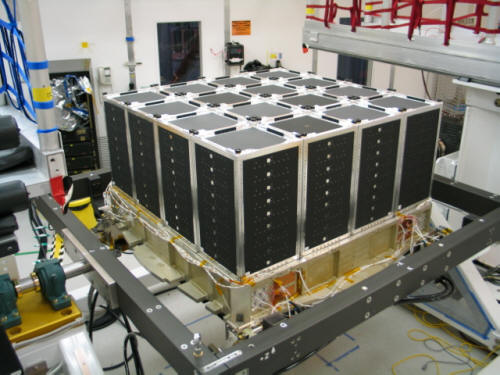
Figure 1. 16 towers installed on the LAT
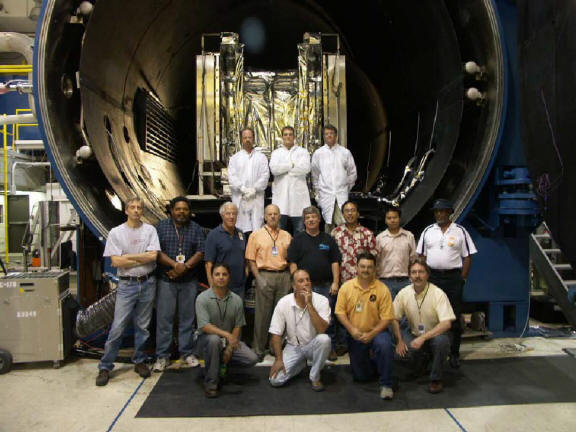
Figure 2. The LAT in the thermal-vacuum chamber at
NRL Figure 3. The LAT ready to ship to General Dynamics
for integration onto GLAST
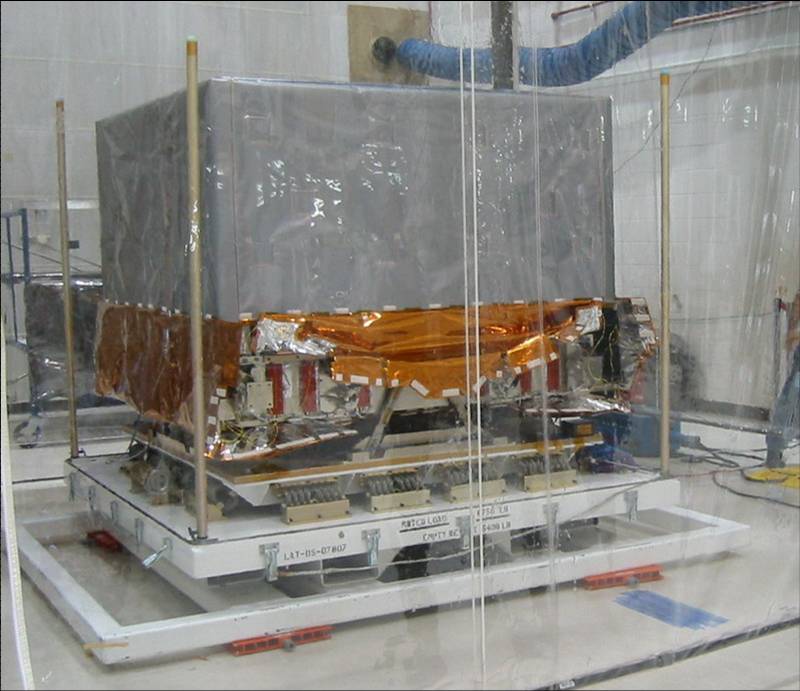
Figure 3. The LAT ready to ship to
General Dynamics for integration onto GLAST
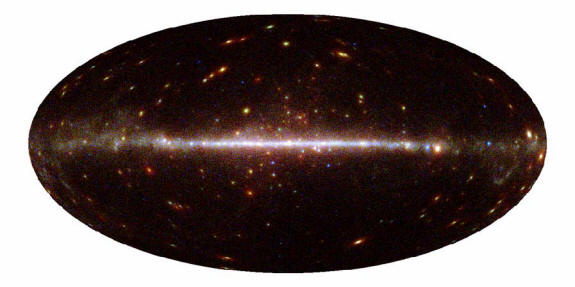
Figure 4. Sky map of gamma rays detected by the LAT
in the Data Challenge 2 simulation.
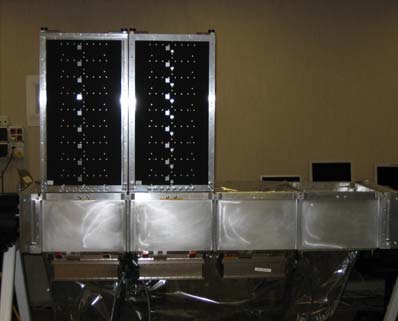
Figure 5. The Calibration Unit (CU) used for the beam
test at CERN.
LSST
The prime goal of LSST is a precision measure of the
nature of dark energy though a suite of techniques using
a homogeneous imaging data set. Central of these is weak
lens shear of galaxy shapes to z=3 by mass at z<3,
giving a unique probe of dark energy. This will be done
through a combination of deep-wide multiband imaging
data over 20,000 sq.deg. in a weak lensing survey of
unprecedented sensitivity x volume and quality. By
measuring the gravitational lens distorted shapes of
billions of galaxies as a function of angle on the sky
and photometric red shift out to z=3, and using galaxy
P(k) from these same data together with WMAP and Planck
data, LSST will constrain six eigenmodes of the dark
energy equation of state parameter. The shear power
spectra and 3-point correlations depend on the growth
function and angular diameter distances, which are both
sensitive to the equation of state of dark energy. The
technique used in these forecasts is lensing tomography
with the auto- and cross-power spectra of the lensing
shear. LSST will also measure with record precision:
baryon acoustic oscillations, hundreds of thousands of
SNe, and clusters of galaxies — three additional
cosmological diagnostics providing independent
constraints on dark energy.
LSST will be a large, wide-field ground-based telescope
designed to obtain sequential images of the entire
visible sky every few nights. The optical design
involves a 3-mirror system with an 8.4 m primary, which
feeds three refractive correcting elements inside a
camera, providing a 10 square degree field of view
sampled by a 3 gigapixel focal plane array. The total
effective system throughput, AΩ = 318 m 2 deg2, is
nearly two orders of magnitude larger than that of any
existing facility. The survey will yield contiguous
overlapping imaging of 20,000 – 23,000 square degrees of
sky in 6 optical bands covering the wavelength regime
350–1100 nm.
A collaboration led by SLAC is building the LSST camera
which is a wide-field optical (0.35-1 µm) imager
designed to provide a 3.5 degree FOV with better than
0.2 arcsecond sampling. The camera includes a filter
mechanism and shuttering capability. It is positioned in
the middle of the telescope where cross-section area is
constrained by optical vignetting and heat dissipation
must be controlled to limit thermal gradients in the
optical beam. The fast, f/1.2 beam will require tight
tolerances on the focal plane mechanical assembly. SLAC
personnel occupy several leadership positions within the
project. Steven Kahn is the Deputy Director of the LSST
project overall, and is the Lead Scientist for the
Camera. Kirk Gilmore is the Camera Project Manager.
Roger Blandford, the Director of KIPAC, is a member of
the LSST Corporation Board of Directors.
During the past year, substantial progress has been made
on the camera development. Camera body/cryostat modeling
as well as overall metrology is currently being
developed by SLAC designers and engineers. The current
level of design is leading to several years of R&D that
will include extensive prototyping of the major
components of the camera. Part of the prototyping effort
is motivated by retiring the risk associated with state
of the art components.
The LSST Camera focal plane contains a large array of
imagers. The challenge is the development of imagers
which meet LSST’s specifications on pixel size, QE,
flatness, dead area and readout speed. All the
specifications have been achieved in previously used CCD
arrays; the development task involves integrating all
the required features into a single sensor. The LSST
sensor working group, which includes members of the LSST
at SLAC team, currently has several vendors under
contract to develop study sensors that will help
determine the final operating characteristics of the
science detectors. LSST’s fast optics produce a very
narrow depth of field which requires that the focal
plane be flat within 10 µm. The R&D program for the LSST
camera will focus on understanding the best techniques
to employ to keep the focal plane flat to the high
precision tolerances required. Initial studies will
include the development of various motion control
scenarios to actively maintain flatness of the raft (3x3
detector array) under a variety of thermal and
mechanical conditions.
LSST filters present special fabrication challenges to
achieving spatially uniform passband characteristics
necessary to do <1% photometry. These include achieving
the necessary thermal and mechanical stability. A
development program spearheaded by SLAC personnel is
currently under way with the ultimate goal of
fabricating a full-scale prototype which demonstrates
the necessary performance characteristics over the full
field.
In terms of scientific investigations, science
collaboration groups have been formed to address the
issues associated with the major scientific projects of
the LSST. These Science Collaborations will work closely
with the LSST Project as it builds the telescope,
camera, and software, and will be expected to play a
substantial role in the scientific commissioning of the
project. The major input of the science collaboration
groups will help identify and resolve key scientific
issues. KIPAC is heavily represented on most of the
collaborations.
A camera face-face meeting was held at SLAC in FY06 and
was attended by 48 LSST personnel with 37 people from
partner institutions and 11 people from SLAC. SLAC also
hosted an LSST simulations workshop and operations
simulator workshop in FY06.
Below is an image of the LSST camera body with the
cryostat. The raft tower contains the detector and the
electronics. The diameter of the L1/L2 housing is about
1.7 meters.
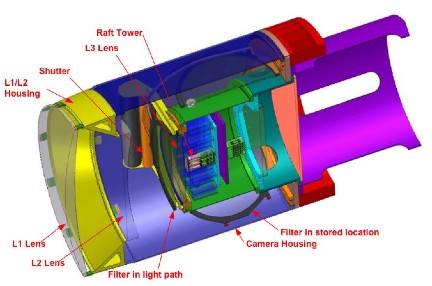
SNAP
The Supernova Acceleration Probe (SNAP) is a proposal
for a space-based wide-field telescope designed to study
the physics of dark energy using calibrated Type 1a
supernovae as standard candles. The mission will also
enable weak lensing studies with high precision over
moderate angular scales. The SNAP design includes a
large focal plane tiled with both visible-light and
infrared-imaging sensors, as well as a visible/IR
spectrograph suitable for following up detected
supernovae.
SLAC/Stanford proposed to join the SNAP collaboration in
August of 2003. That application was formally approved
in March 2004. Within the collaboration, SLAC is
responsible for the design and development of the SNAP
Instrument Control Unit (ICU) and the focal plane
guiding system. SLAC scientists also provide significant
support of the strong lensing abilities of the SNAP
telescope.
The ICU performs electronic supervision of the entire
SNAP instrument, executes the science mission, manages
the operation of instrument mechanisms and thermal
controls, and controls the flow of commands and data
between the focal plane electronics, mass memory and
spacecraft. This effort is led by Gunther Haller who has
been hosting semimonthly electronics exchange (elex)
meetings between SLAC, FNAL and LBL. The SNAP mission
desires to have all focal plane components maintained at
a common temperature without thermal control on each
device. Over the last year the ICU team have been
studying of the thermal properties of the focal plane
and developing communications protocols between the warm
electronics and the cold focal plane components. The
level 3 electronic requirements document and on deck
component layout studies are being developed.
The focal plane guiding system will allow the SNAP
observatory to track its science fields to an accuracy
of better than 20 milliarcseconds. SNAP intends to use a
new technical approach, consisting of four
asynchronously operated imaging devices, controlled by a
central processor. This system will collect sufficient
photons to generate an appropriate error signal for the
spacecraft pointing system. By operating the sensors
asynchronously, the integration time for each device can
be tailored to the number and brightness of stars
available with the field of view. This approach was
simulated and compared with worst-case star field
density and shown to meet the accuracy requirements. In
collaboration with Lockheed Martin LLC, Bill Craig,
Kevin Reil and Johnny Ng have been developing a test-bed
prototype to confirm the pointing requirements. Studies
using this test-bed should be completed over the next
year.
SLAC scientists have also played a significant role in
formulating the detailed scientific program for SNAP,
especially with regard to strong lensing investigations.
The SNAP database should reveal a large number of new
strong lenses. Measurements of the properties of these
lensed images will yield a number of interesting
constraints on cosmological models. SLAC scientists
including Phil Marshall, Roger Blandford, Masao Sako
[see 2005-01-16 New Astronomy Reviews 49 387 (2005)],
have provided support for strong lensing science from
SNAP. Currently, in support of the scientific promise of
SNAP, studies of existing data in the HST ACS archive
are underway. Information on their search for lenses in
this existing data can found in
http://arxiv.org/abs/astro-ph/0607239.
Computing
KIPAC members have strong research programs spanning
much of high energy astrophysics and cosmology including
gamma-ray, X-ray and radio astronomy, modeling of
gamma-ray bursts, active galactic nuclei, pulsars and
supernova remnants. Generic, high energy astrophysics
processes, such as relativistic shock waves and particle
acceleration are also being studied. Most of these
scientific programs require high performance computing
and this has been a major feature of KIPAC's plans since
its inception. Data handling, data analysis and
numerical modeling activities are driving this
development. In 2006, major efforts included searching
the Hubble Space Telescope database for gravitational
lenses and cosmic strings, analysis of X-ray
observational rich clusters of galaxies, numerical
modeling of the kinetic structure of supersonic and
relativistic shock fronts, determining the properties
and consequences of the first stars to form in the
universe and modeling the production of gamma-ray bursts
during the collapse of massive stars. A more complete
tour of computational activities at KIPAC is available
on the web at:
http://www-group.slac.stanford.edu/kipac/comp_physics.htm
.
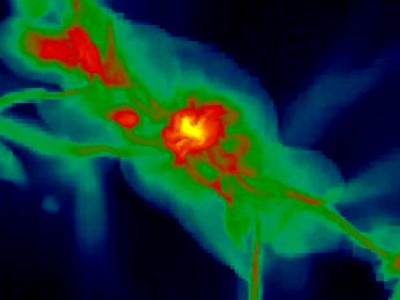
Using adaptive mesh refinement cosmological
hydrodynamics calculations the collapse of primordial
gas is followed over 25 orders of magnitude in density
with a maximal dynamic range of 1015. Simulations are
being carried out on the KIPAC, 72 processor SGI Altix
supercomputer.
To support these activities KIPAC has established a
computing department with 2006 as its first full year.
Development has begun of a sustained computing program
comprising four elements: processing cycles,
data/storage management, visualization, and personnel.
Current processing capability includes a 72-processor
SGI Altix SMP system, KIPAC's 12-node set of Apple
compute servers, access to the Advanced Computation
Department’s myrinet clusters for MPI jobs, SLAC's batch
servers, and individual users’ desktops. These resources
have been used aggressively to carry out many projects
but to date, computing capability has been a source of
limitations. These systems will be augmented with a
64-node cluster in late 2006 specifically tailored for
numerical astrophysics computations. Additionally,
KIPAC’s SGI Altix is being upgraded with additional
memory specifically to facilitate cosmological
simulations that require larger dynamic range.
This year (2006) development began of a long term
“Data Lifecycle Management” program which includes
tiered storage and planned growth. KIPAC purchased 30 TB
of storage and plan for approximately constant annual
costs (As cost per unit storage decreases ) to keep up
with increasing demand. An implementation is currently
being tested of a high performance storage system to
support the compute cluster environment where I/O
performance can be a significant enabling factor in
scientific output.
Visualization capabilities have also been developed in
2006 with prototype 3-D projection and 2D tiled display
systems suitable for software development and modest
data interaction. Use of these facilities includes
creating three-dimensional movies, using multiscreen
displays of high dimensional parameter spaces and
exploring new methods to exhibit three-dimensional
vectors like magnetic field. The strong graphical
content of observational and theoretical astrophysics
and cosmology makes it ideal for education and public
outreach.
With the move into the Fred Kavli Building in mid 2006,
the process of building personnel resources and
communication mechanisms has been enhanced. Five FTEs
are currently resident at KIPAC and SLAC’s Scientific
Computing and Computing Services (SCCS) group supporting
computing. Regular meetings are held with SCCS twice per
month and an external review of our computing plan was
held in March 2006. An expert in scientific
visualization is being recruited to join KIPAC.
Additionally, substantial use is made of our SU campus
location at
kipac.stanford.edu
to host KIPAC-specific computing documentation and group
communications.
As the year closes, negotiations with vendors are in
progress to obtain a low-latency compute cluster with 64
nodes (each with 4 cpu cores), 512 GB total memory and
10 TB of parallel disk storage. KIPAC staff are
collaborating with SCCS to develop the specialized
configurations needed for numerical astrophysics. Staff
are also working closely with SCCS to design and
integrate this new system with the existing storage and
visualization capabilities. This system will augment
substantially the existing research programs and provide
a significant capability to the incoming group of
postdocs.
Other Activities
NuSTAR
NuSTAR is a satellite-based instrument to image hard
X-ray radiation from celestial sources. This experiment
is led by Caltech (Fiona Harrison, PI), but with a
substantial involvement of KIPAC scientists (W. Craig,
G. Madejski, R. Blandford) in addition to participants
from JPL, UCSC, and Columbia University. The technical
approach is via the use of multilayer grazing incidence
optics focusing hard X-rays onto pixilated CdZnTe
detectors. This approach dramatically reduces the
particle- and Cosmic X-ray background, resulting in at
least a 100-fold sensitivity improvement over any
previous instruments. The science goals of the mission
are: to study the production of heavy elements in
supernovae; to determine the origin of the celestial
hard X-ray background (where most of its energy is
detected); and to provide for a tool to study
relativistic jets in celestial sources via simultaneous
observations with the GLAST satellite (also involving
SLAC personnel).
This instrument was selected by NASA via a competitive
process for the extended definition study in the
Explorer program, with the goal of launch in 2009.
Unfortunate budgetary constraints at NASA led to the
termination of funding for the project. However, since
this experiment was the top-rated astrophysics mission
in the Explorer class, and the science objectives remain
extremely compelling, it is anticipated that it will be
either reinstated, or will be highly competitive in the
next Announcement of Opportunity, expected next year.
The NuSTAR team is fully committed to its success.
Even if NASA chooses not to be involved in the sensitive
exploration of the hard X-ray sky, there is a highly
competitive international program with similar goals.
The most viable is the Japanese-led mission NeXT, which
is identified as the next high energy astrophysics
effort of the Japanese Space Agency JAXA. With the
intended launch of 2012-2013, NeXT will include an
imaging hard X-ray instrument similar in design to
NuSTAR, but also will include detectors sensitive in
soft X-ray, and soft gamma-ray bands. KIPAC scientists
are part of the NeXT collaboration, and fully intend to
participate, since such work is likely to enhance the
scientific return of the GLAST (and LSST!) projects.
PoGO
PoGO is a balloon-borne hard X-ray polarimeter that
consists of well-type phoswich scintillation counters to
study polarization of hard X-ray flux from celestial
sources. PoGO is funded by a Stanford Campus fund in the
US, the Warrenburg Foundation in Sweden (PI is Mark
Pearce of the Royal Institute of Technology), three
grants from Grants-in-Aid in Japan (PIıs are Jun Kataoka
of Tokyo Institute of Technology, Yasushi Fukazawa of
Hiroshima University and Tune Kamae as a professor
emeritus of University of Tokyo). A proposal was also
submitted to NASA, which is being reviewed right now.
A beam test has been completed using synchrotron light
to study the performance and another beam test using
proton beam to study the effect of cosmic rays.
Developments of detector elements, readout electronics,
data acquisition system, gondola and pointing system are
on track for the first balloon flight in 2009 spring.